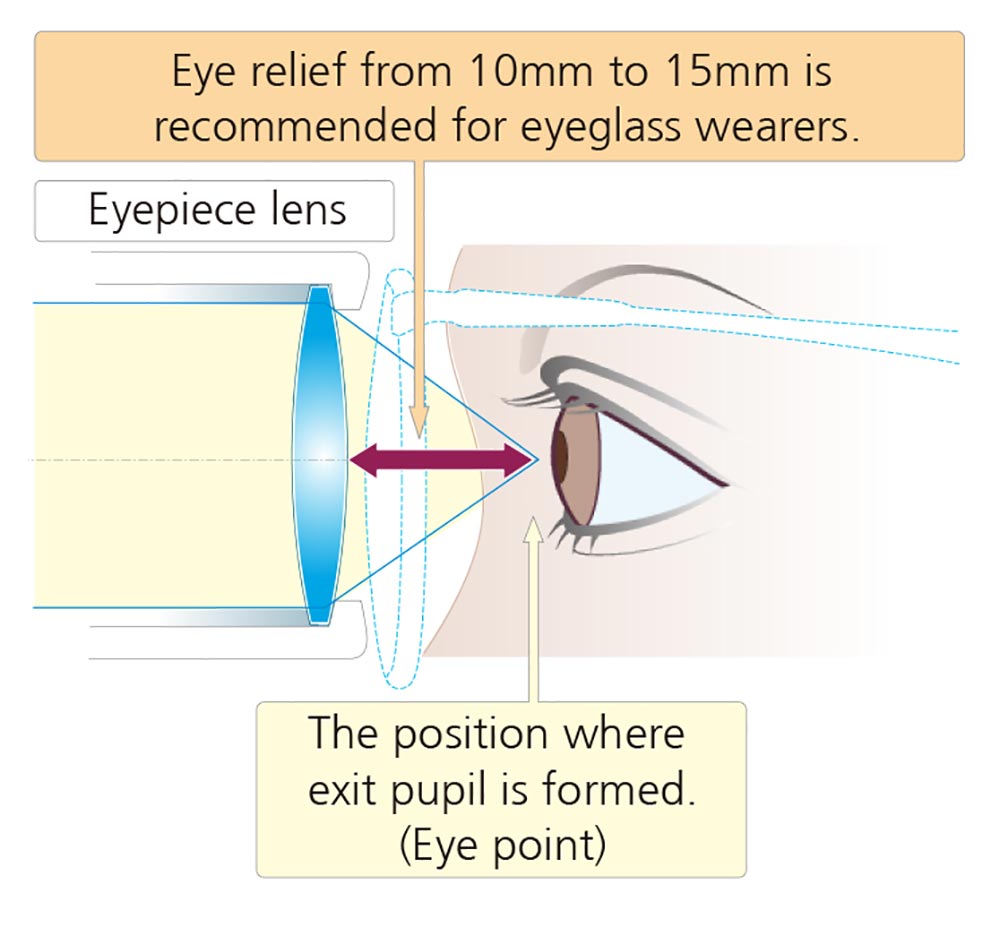Choose by specifications
How to Choose Binoculars
There are various elements that determine binocular performance. When choosing binoculars, please examine the following.
- Magnification
- Effective diameter of the objective lens
- Exit pupil (brightness)
- Real field of view
- Apparent field of view
- Field of view at 1,000 meters
- Eye relief
- Close focusing distance
- Waterproof
Magnification
Higher magnification does not necessarily mean better binoculars. An appropriate magnification depends on applications and subjects. Binoculars with magnification up to 12x are recommended for comfortable handling and viewing by general users.
Higher magnification causes such disadvantages as a narrow field of view, unstable image caused by hand movement, and a small exit pupil that makes the image darker. These factors make it difficult to observe moving subjects or locate distant objects.
Are zoom binoculars convenient?
Zoom binoculars provide a range of magnifications. For example, when using them at a concert hall, while you can take in the whole atmosphere of the hall at low magnification, you can also zoom in to your favorite performer or particular scenes at high magnification. However, note that as the magnification becomes higher, the field of view will be narrower, and unstable image caused by hand movement is likely to occur. Please be aware of these factors before using zoom binoculars.
Extremely high magnifications
With binoculars featuring extremely high zoom ratio such as 50x or 100x, observation becomes very difficult.
Example: with 100x50 binoculars (100x magnification, 50mm effective diameter of the objective lens)
- The field of view becomes extremely narrow, making it harder to observe objects.
- The exit pupil becomes as small as 0.5mm so that you will perceive a dark field of view. Even in bright conditions, the human pupil doesn't become smaller than 2mm. A 0.5mm exit pupil is insufficient to gather light for your eyes and makes the field of view too dark.
- The image you view will become easily affected by hand movement, making it difficult to use binoculars for hand-held observation.

Effective diameter of the objective lens
If the magnification is the same, the larger the objective diameter is, the greater the light-collecting power. This results in higher resolution and a brighter image. However, large-diameter objective lenses make binoculars heavier and larger.
Exit pupil and brightness
The exit pupil is the bright circle that can be seen in the center of the eyepiece when you hold the binoculars about 30cm away from your eyes with the objective lenses pointed toward a bright light. The bigger the diameter of the exit pupil is, the brighter the viewfield image will be — an important factor when using binoculars at dawn, dusk and for astronomical observation.
The diameter of the exit pupil is obtained using the following formula:
Exit pupil = Effective diameter of the objective lens ÷ Magnification
Real field of view
Real field of view is the angle of the visible field, seen without moving the binoculars, measured from the central point of the objective lens. The larger the value is, the wider the viewfield you obtain. For example, binoculars with a wider field of view are advantageous for locating fast-moving wild birds within the viewfield. This also applies for finding small nebulas or a cluster of stars in astronomical observations.
Apparent field of view
Apparent field of view is the angle of the magnified field when you look through binoculars. The larger the apparent field of view is, the wider the field of view you can see even at high magnifications.
For example, an apparent field of view of 8x binoculars with 7.0° is as follows:
- 2ω'= 2 x tan-1 (Γ x tan ω)
= 2 x tan-1 (8 x tan 3.5°)
= 52.1°
Field of view at 1,000m
This is the width of the visible area at a distance of 1,000 meters, which can be seen without moving the binoculars.
Eye relief
The position where the exit pupil is formed is called eyepoint. The distance from the outer surface of the eyepiece lens to the eyepoint is called eye relief.
Looking through binoculars from the eyepoint, you can obtain the whole field of view without vignetting.
With binoculars with eye relief of 15mm or longer (high eyepoint type), eyeglass wearers can obtain a field of view with no vignetting without removing their eyeglasses.

Close focusing distance
This indicates the distance to the nearest point that can be focused. Generally, binoculars are used to make distant objects appear nearer. However, you can also enjoy magnified images from a close distance, such as when appreciating works of art or observing plants and insects. In this case, the shorter the focus distance of binoculars, the more details you can see. Minimum close focusing distance of binoculars is about 1 to 2 meters.
Waterproof
Nikon's waterproof binoculars keep body tubes airtight, and nitrogen gas is filled. These factors are effective in preventing fog and mold inside an optical system. However, binoculars should not be used underwater. When waterproof binoculars get wet, wipe the water off thoroughly and dry them.
